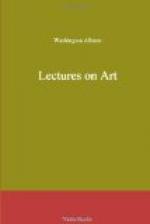Contents
Preface By The Editor
Lectures on Art.
Preliminary Note.—Ideas
Introductory Discourse
Art
Form
Composition
Aphorisms.
Sentences Written by Mr. Allston on the
Walls of His Studio
The Hypochondriac
Lectures on Art.
Preliminary Note.
Ideas.
As the word idea will frequently occur, and will be found also to hold an important relation to our present subject, we shall endeavour, in limine, to possess our readers of the particular sense in which we understand and apply it.
An Idea, then, according to our apprehension, is the highest or most perfect form in which any thing, whether of the physical, the intellectual, or the spiritual, may exist to the mind. By form, we do not mean figure or image (though these may be included in relation to the physical); but that condition, or state, in which such objects become cognizable to the mind, or, in other words, become objects of consciousness.
Ideas are of two kinds; which we shall distinguish by the terms primary and secondary: the first being the manifestation of objective realities; the second, that of the reflex product, so to speak, of the mental constitution. In both cases, they may be said to be self-affirmed,—that is, they carry in themselves their own evidence; being therefore not only independent of the reflective faculties, but constituting the only unchangeable ground of Truth, to which those faculties may ultimately refer. Yet have these Ideas no living energy in themselves; they are but the forms, as we have said, through or in which a higher Power manifests to the consciousness the supreme truth of all things real, in respect to the first class; and, in respect to the second, the imaginative truths of the mental products, or mental combinations. Of the nature and mode of operation of the Power to which we refer, we know, and can know, nothing; it is one of those secrets of our being which He who made us has kept to himself. And we should be content with the assurance, that we have in it a sure and intuitive guide to a reverent knowledge of the beauty and grandeur of his works,—nay, of his own adorable reality. And who shall gainsay it, should we add, that this mysterious Power is essentially immanent in that “breath of life,” by which man becomes “a living soul”?
In the following remarks we shall confine ourself to the first class of Ideas, namely, the Real; leaving the second to be noticed hereafter.
As to number, ideas are limited only by the number of kinds, without direct relation to degrees; every object, therefore, having in itself a distinctive essential, has also its distinct idea; while two or more objects of the same kind, however differing in degree, must consequently refer only to one and the same. For instance, though a hundred animals should differ in size, strength, or color, yet, if none of these peculiarities are essential to the species, they would all refer to the same supreme idea.




